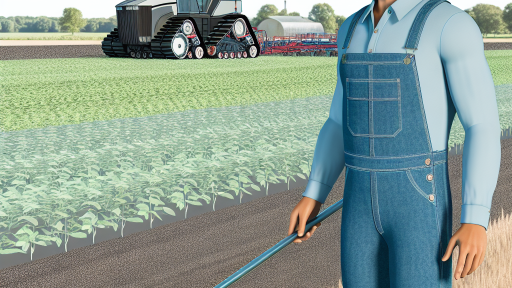Introduction to Sustainable Farming
!wp:/heading — !wp:paragraph —Sustainable farming practices play a crucial role in promoting biodiversity.
!wp:/paragraph — !wp:paragraph —This approach aims to enhance ecosystem health while providing food resources.
!wp:/paragraph — !wp:paragraph —Farmers can adopt methods that bolster both their yields and environmental sustainability.
!wp:/paragraph — !wp:heading {“level”:3}The Importance of Biodiversity
!wp:/heading — !wp:paragraph —Biodiversity ensures ecological resilience and stability within farming systems.
!wp:/paragraph — !wp:paragraph —Healthy ecosystems provide essential services such as pollination and pest control.
!wp:/paragraph — !wp:paragraph —In addition, diverse farming systems promote soil health and nutrient cycles.
!wp:/paragraph — !wp:heading {“level”:3}Connecting Farming and Ecosystems
!wp:/heading — !wp:paragraph —Sustainable farming integrates agricultural practices with ecological principles.
!wp:/paragraph — !wp:paragraph —This integration helps maintain the balance between crop production and wildlife conservation.
!wp:/paragraph — !wp:paragraph —Moreover, it fosters habitats for various species, enhancing overall biodiversity.
!wp:/paragraph — !wp:heading {“level”:3}Challenges in Conventional Farming
!wp:/heading — !wp:paragraph —Conventional farming often leads to habitat destruction and monocultures.
!wp:/paragraph — !wp:paragraph —These practices can severely limit biodiversity and ecosystem services.
!wp:/paragraph — !wp:paragraph —Additionally, reliance on chemical inputs can degrade soil health over time.
!wp:/paragraph — !wp:heading {“level”:3}Benefits of Sustainable Practices
!wp:/heading — !wp:paragraph —Sustainable practices like crop rotation and organic farming improve biodiversity.
!wp:/paragraph — !wp:paragraph —Reduced use of pesticides supports beneficial insect populations.
!wp:/paragraph — !wp:paragraph —Similarly, integrating cover crops enhances soil structure and fertility.
Transform Your Agribusiness
Unlock your farm's potential with expert advice tailored to your needs. Get actionable steps that drive real results.
Get StartedCommunity and Economic Impact
!wp:/heading — !wp:paragraph —Engaging communities in sustainable farming fosters local stewardship.
!wp:/paragraph — !wp:paragraph —It empowers farmers to make decisions that benefit both the environment and their livelihoods.
!wp:/paragraph — !wp:paragraph —Furthermore, sustainable farming can enhance market opportunities for local products.
!wp:/paragraph —Types of Sustainable Farming Practices That Enhance Biodiversity
Crop Rotation
Crop rotation involves alternating different crops on the same land.
This practice helps improve soil health and reduce pest populations.
It enhances biodiversity by providing varied habitats for beneficial insects.
Cover Cropping
Cover cropping uses specific plants to cover the soil during off-seasons.
These crops prevent soil erosion and suppress weeds effectively.
Moreover, they enhance soil fertility and promote the presence of pollinators.
Agroforestry
Agroforestry integrates trees and shrubs into crop or livestock systems.
This practice creates diverse ecosystems that support wildlife habitats.
Additionally, it improves water retention and reduces the need for chemical fertilizers.
Organic Farming
Organic farming reduces chemical inputs and focuses on natural processes.
It promotes soil health through composting and natural pest control methods.
This practice fosters a diverse array of beneficial organisms in the soil.
Integrated Pest Management
Integrated Pest Management uses multiple strategies to control pests.
It combines biological control, habitat manipulation, and resistant varieties.
This holistic approach minimizes chemical usage and supports diverse ecosystems.
Conservation Tillage
Conservation tillage retains soil cover and minimizes soil disturbance.
This practice enhances soil structure and moisture retention.
Moreover, it provides habitats for various organisms, improving overall biodiversity.
Permaculture
Permaculture designs agricultural ecosystems that mimic natural ecosystems.
This approach fosters biodiversity through intercropping and polyculture practices.
Additionally, it promotes soil health and sustainability over time.
Showcase Your Farming Business
Publish your professional farming services profile on our blog for a one-time fee of $200 and reach a dedicated audience of farmers and agribusiness owners.
Publish Your ProfileThe Role of Crop Rotation in Increasing Soil Health and Habitat Diversity
Enhancing Soil Nutrients
Crop rotation enriches soil by alternating plant families.
This practice helps replenish nutrients naturally.
For instance, legumes fix nitrogen, benefiting subsequent crops.
Moreover, it reduces the need for synthetic fertilizers.
Improving Soil Structure
Diverse root structures contribute to better soil aeration.
Healthy soil structure enhances water retention capabilities.
This promotes a balanced ecosystem and protects against erosion.
As a result, healthier crops thrive and yield better harvests.
Encouraging Biodiversity
Crop rotation creates varied habitats for wildlife.
This supports a wide range of beneficial insects and organisms.
Increased biodiversity leads to natural pest control.
Consequently, farmers can minimize pesticide use effectively.
Mitigating Pest and Disease Pressure
Rotating crops disrupts pest life cycles significantly.
This interference reduces the buildup of harmful pathogens.
Farmers experience fewer crop losses due to disease outbreaks.
Ultimately, this practice enhances productivity and resilience.
Learn More: Choosing the Right IPM Tools for Your Farm
Integrating Livestock and Crop Systems for Enhanced Ecosystem Functionality
Benefits of Integrated Systems
Integrating livestock with crop systems promotes nutrient cycling.
This approach enhances soil fertility significantly.
Livestock contribute organic matter through manure.
Crops utilize these nutrients, reducing the need for chemical fertilizers.
Additionally, livestock grazing controls weeds effectively.
This minimizes competition for crops, leading to healthier yields.
Improved Biodiversity
The integration of livestock and crops boosts on-farm biodiversity.
Diverse plant and animal interactions create robust ecosystems.
These interactions support various microorganisms in the soil.
Moreover, increased biodiversity helps with pest control.
Natural predators thrive, reducing pest populations without chemicals.
Practical Implementation Strategies
Farmers can adopt rotational grazing techniques easily.
This practice involves moving livestock between pastures regularly.
It prevents overgrazing and promotes grass regrowth.
Simultaneously, intercropping methods can be implemented.
Crops like legumes can fix nitrogen, benefiting companion plants.
Challenges and Considerations
Despite the benefits, challenges exist in this integration.
Farmers must manage livestock and crops effectively.
They should monitor animal health closely to prevent diseases.
Moreover, understanding local ecosystems is crucial for success.
Careful planning is essential to maximize the benefits.
Explore Further: Carbon Sequestration Technologies for Modern Farms
Utilizing Cover Crops and Green Manures to Improve Soil Structure and Biodiversity
The Role of Cover Crops
Cover crops serve multiple beneficial purposes in sustainable farming.
Showcase Your Farming Business
Publish your professional farming services profile on our blog for a one-time fee of $200 and reach a dedicated audience of farmers and agribusiness owners.
Publish Your ProfileThey enhance soil fertility and structure effectively.
Additionally, they prevent soil erosion, maintaining the topsoil layer.
Different species of cover crops can attract beneficial insects.
Farmers can choose legumes, grasses, or brassicas based on their needs.
Legumes, for instance, fix nitrogen, enriching the soil further.
In contrast, grasses improve soil organic matter through their root systems.
Overall, cover crops contribute significantly to agricultural biodiversity.
The Benefits of Green Manures
Green manures are another effective tool for enhancing soil health.
They consist of crops grown primarily to be incorporated into the soil.
This process adds organic matter and nutrients back to the earth.
Moreover, green manures can help suppress weeds naturally.
Farmers can plant green manures during fallow periods to utilize time efficiently.
These crops decompose quickly, improving soil texture and moisture retention.
The incorporation of green manures promotes beneficial microbial activity.
Improving Soil Structure
Incorporating cover crops and green manures can significantly enhance soil structure.
The plant roots create channels, improving water infiltration and retention.
This leads to healthier crops and reduced dependency on irrigation.
Earthworms and beneficial organisms thrive in well-structured soil.
Moreover, enhanced soil structure leads to better aeration and root development.
Ultimately, healthy soil contributes to increased agricultural yields sustainably.
Impact on Biodiversity
Utilizing cover crops and green manures greatly impacts biodiversity positively.
These practices attract a variety of beneficial organisms including pollinators.
They also provide habitats for various wildlife species on farms.
The increased plant diversity helps build a more resilient ecosystem.
Crop rotations involving different cover crops reduce disease pressure.
Consequently, farmers can experience healthier and more productive fields.
Integrating these practices supports a sustainable agricultural model.
Explore Further: Biodiversity’s Impact on Sustainable Food Production
The Importance of Agroforestry in Promoting Wildlife Habitats and Species Diversity
Enhancing Biodiversity
Agroforestry integrates trees and shrubs into agricultural systems.
This unique combination supports a diverse range of habitats.
Consequently, it enhances biodiversity in farming landscapes.
Moreover, agroforestry encourages the presence of beneficial insects.
These insects play a crucial role in pollination and pest control.
Providing Habitat for Wildlife
Agroforestry creates essential habitats for numerous wildlife species.
Trees and shrubs provide shelter and food sources for animals.
For instance, birds find nesting sites in the foliage.
Similarly, mammals benefit from the cover offered by the vegetation.
Conserving Soil and Water
Agroforestry practices improve soil health and water retention.
This leads to better agricultural productivity in the long run.
Healthy soil supports a variety of plant species, which aids biodiversity.
Showcase Your Farming Business
Publish your professional farming services profile on our blog for a one-time fee of $200 and reach a dedicated audience of farmers and agribusiness owners.
Publish Your ProfileAdditionally, tree roots stabilize the soil and prevent erosion.
Promoting Ecosystem Services
Agroforestry contributes to various ecosystem services.
These include carbon sequestration and climate regulation.
As a result, it mitigates the effects of climate change on habitats.
Furthermore, agroforestry enhances nutrient cycling in the environment.
Engaging Local Communities
Local communities benefit from agroforestry through enhanced livelihoods.
By diversifying crops, farmers can generate additional income.
Furthermore, this practice fosters a sense of community engagement.
Ultimately, this encourages stewardship of local ecosystems.
Discover More: 5 Sustainable Farming Techniques That Are Changing the Game

Managing Pests Naturally Through Integrated Pest Management (IPM) Strategies
Understanding Integrated Pest Management
Integrated Pest Management, or IPM, is a holistic approach to pest control.
It combines different practices to minimize pest damage sustainably.
Farmers implement IPM by monitoring pest populations effectively.
Then, they use a variety of control methods to manage these pests.
Principles of IPM
IPM relies on understanding pest life cycles and behaviors.
Additionally, it considers the ecosystem’s balance when applying controls.
Farmers prioritize non-chemical methods to tackle pest issues.
These methods often include biological controls and cultural practices.
Consequently, they help maintain healthy pest levels without chemicals.
Biological Control Methods
Many farmers utilize natural predators to control pest populations.
For example, ladybugs can effectively manage aphid outbreaks.
Additionally, parasitic wasps serve to control caterpillar pests.
These biological agents reduce the need for chemical pesticides.
Cultural Practices to Prevent Pests
Cultural practices help create practices that deter pests from crops.
Crop rotation is a vital practice that disrupts pest life cycles.
Furthermore, intercropping different plants can confuse pests.
Proper sanitation in the fields also helps to eliminate pest habitats.
Ultimately, these practices reduce pest establishment and survival.
Monitoring and Action Thresholds
Monitoring pest populations helps farmers decide when to act.
Using action thresholds allows farmers to determine acceptable pest levels.
Farmers can avoid unnecessary treatments and focus on critical times.
This strategy ensures economic viability and environmental safety.
Utilizing Pesticides Judiciously
When necessary, IPM encourages the responsible use of pesticides.
Farmers select the least toxic options for specific pest problems.
They also apply pesticides at the right times to maximize effectiveness.
This practice ensures minimal harm to beneficial organisms.
Thus, even when using chemicals, they maintain a balanced ecosystem.
Community Involvement and Education in Sustainable Farming for Biodiversity Conservation
The Importance of Community Engagement
Community involvement fosters a sense of ownership among local farmers.
Engaging communities promotes dialogue around sustainable practices.
Additionally, community participation enhances local ecological knowledge.
Showcase Your Farming Business
Publish your professional farming services profile on our blog for a one-time fee of $200 and reach a dedicated audience of farmers and agribusiness owners.
Publish Your ProfileEducational Programs and Workshops
Educational initiatives are essential for spreading awareness about sustainability.
Workshops can teach farmers innovative techniques for biodiversity conservation.
Furthermore, these programs can illustrate the benefits of sustainable farming.
Collaboration with Local Organizations
Partnering with nonprofits can amplify conservation efforts.
Organizations like Green Future provide resources for farmers.
Moreover, these collaborations can create a support network for knowledge sharing.
Creating a Culture of Sustainability
Cultivating a culture of sustainability begins with education.
It encourages practices that benefit both the farm and the environment.
Community events can showcase successful sustainable methods.
Measuring Success and Impact
Assessing the impact of community education is crucial for progress.
Farm biodiversity can be monitored through regular surveys.
Success stories can inspire further participation and innovation.
Building Future Generations of Farmers
Involving youth in sustainable farming initiatives is vital for longevity.
School programs can introduce children to the importance of biodiversity.
Moreover, internships can equip young individuals with practical skills.
Case Studies of Successful Sustainable Farming Practices
Promoting Pollinator Habitats
Farmers like Emily Torres in Oregon enhance biodiversity by planting diverse flowering plants.
These plants attract bees and other pollinators which are crucial for crop production.
Moreover, Emily’s approach increases yields while supporting local ecosystems.
This practice demonstrates how tailored habitats foster vital pollinator populations.
Implementing Crop Rotation
John Liu, a farmer in Iowa, practices crop rotation to enrich the soil.
He alternates corn with legumes, which naturally fix nitrogen in the soil.
This method reduces the need for synthetic fertilizers and boosts soil health.
Additionally, it disrupts pest and disease cycles, enhancing crop resilience.
Using Cover Crops
Maya Patel utilizes cover crops on her farm in Kentucky to prevent soil erosion.
She plants rye and clover during off-seasons to protect soil health.
These crops also provide habitat for beneficial insects.
As a result, Maya sees improved fertility and reduced reliance on chemical inputs.
Integrating Livestock with Crop Farming
Tommy Reed in Texas adopts an integrated farming system with crops and livestock.
He rotates animals through fields, allowing them to fertilize the land naturally.
This approach enhances nutrient cycling and boosts biodiversity.
Furthermore, it creates a more resilient farming ecosystem.
Establishing Agroforestry Systems
In Minnesota, Sarah Johnson has embraced agroforestry techniques on her land.
She intersperses trees with her crops, providing shade and habitat for wildlife.
These systems improve soil moisture retention and mitigate climate extremes.
As a result, the farm becomes more productive and ecologically balanced.
Sustainable Practices and Biodiversity
These case studies showcase diverse sustainable farming practices.
Each farmer contributes uniquely to boosting local biodiversity.
Through their efforts, they highlight the importance of integrating sustainable practices.
These examples inspire others to adopt similar initiatives for a healthier planet.
Additional Resources
Impact of Sustainable Agriculture and Farming Practices
Showcase Your Farming Business
Publish your professional farming services profile on our blog for a one-time fee of $200 and reach a dedicated audience of farmers and agribusiness owners.
Publish Your ProfileSustainable farming practices and soil health: a pathway to …




